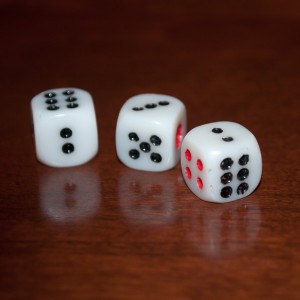What are the odds? Predicting gender split in Soay lambing
Among the ancient rituals in raising sheep — rams vying for dominance during rut, breeding, gestation, lambing, weaning — only one is unique to the humans involved: the shepherd’s daily fret over what portion of the lambs will be ewes. Although we cannot prove it, we’d bet a nice dinner in town that shepherds have fussed about “too many rams” since the first sheep were domesticated thousands of years ago. I can’t do anything to keep you from agonizing about your gender split, but maybe a little data will help.
Whatever may be going on in crocodile, spider, or bird breeding, it has been known for over a hundred years that in mammals, the gender of the offspring is determined by which of the two sex chromosomes the fertilizing sperm carries. That means that fifty per cent of conceptions will result in female embryos and fifty per cent will result in male embryos. So far, so good. But that truism doesn’t do much for me right now given that five of our first six lambs this year are rams. My immediate reaction? Bad start. Woe is me. How will I fill our orders for starter flocks?Time to rely on the facts of our experience to get my blood pressure back down.
We had 405 British Soay lambs born on our farm between 2006 and 2013. We expect to have several dozen more by late May of this year. Of the 405, 212 were ewes and 191 were rams, or 52% ewes and 47% rams. My resident geneticist, he who actually remembers what he learned in statistics, tells me this is “not inconsistent with the proposition that the lamb gender split will be half and half.” I translate that to mean 52/47 is right on target.
In other words, which gender a lamb will be is a coin flip every time a lamb is conceived. Any deviation from 50/50 in offspring born probably is explained by differential survival of the sperm, hormonal competition between twins, and similar issues better left to the textbooks and the experts.
For the eagle-eyed among my readers, what about that missing percentage point and my apparent inability to add? We have had two stillborn lambs whose gender we simply did not check for. If both of them had been one or the other gender, it would still make a miniscule difference in the percentages.
One more aspect of the math involved here may be worth noting. It should be the case that the larger the data set from which the percentage of ewe lambs and the percentage of ram lambs are calculated, the closer the gender split will be to 50/50. You can judge for yourself whether our experience bears out this notion:
[table th=”0″ colalign=”center|center|center|center|center”]
Saltmarsh Ranch British Soay Lamb Gender Split [attr colspan=”4″ style=”font-weight: bold;”]
Year, Total Lambs, % Ewe Lambs, % Ram Lambs
2006, 8, 75%, 25%
2007, 30, 50%, 50%
2008, 34, 40%, 60%
2009, 57, 63%, 37%
2010, 60, 52%, 48%
2011, 58, 50%, 50%
2012, 77, 47%, 53%
2013, 81, 55%, 45%
2014, ?, ?, ?
[/table]
Before this year, we had “lost” the gender lottery only twice in the last eight years. I like those odds and I’m not giving up hope for at least a 50/50 split again this year.
For now …
